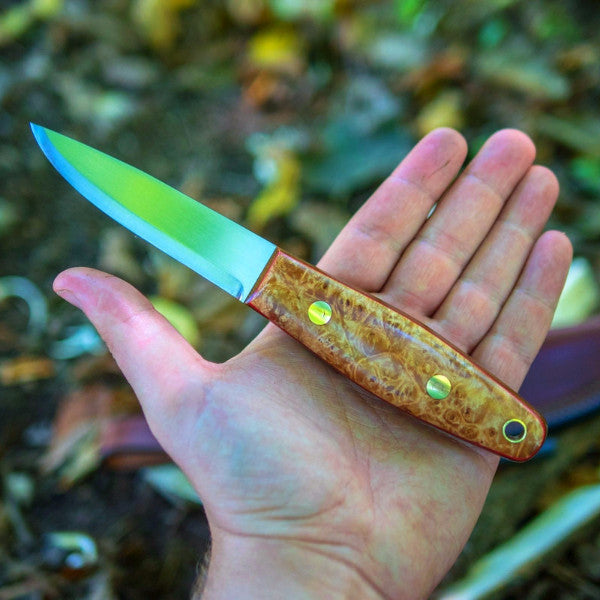Edit: 3/13/2018: This blog post is soon to be updated with the lastest revision of the Woodsman model.
Here I'd like to take a quick look at our Adventure Sworn Woodsman bushcraft knife. This knife was designed to be a general-use, versatile knife for use in the outdoors.
The inspiration of the knife comes from two sources. The first source is the Mora Classic; I've always loved the simplistic, time-tested design of this knife, and always wanted to see it's attributes on a full-tang custom knife. The second source of inspiration is by the world famous bushcraft expert Mors Kochanski, a woodsman who loves Mora knives. In Mors' book Bushcraft, Outdoor Skills and Wilderness Survival, Mors goes into detail about what he thinks makes a great bushcraft knife. I agree with many of his points and kept true to many of his recommendations.
Here I will show some attributes of the Woodsman model, supplemented with quotes by Mors Kochanski from his chapter on knifecraft.
"The knife is the smallest and most portable of all the cutting tools. Light and unobtrusive, the knife is readily available for hundreds of everyday tasks in bush living."
"The general-purpose bush knife should have a blade as long as the width of the palm, although blades half or twice this length are within acceptable limits. A blade five centimeters long would be an excellent survival knife except for being too small to fall and limb trees of wrist-thickness. A blade 10 to 15 centimeters long will do intricate work like carving a netting needle, yet be large enough to present a good target for a baton when cutting down small trees. A blade 20 centimeters long is a superior tool for heavy work, but awkward to use for fine work."
"The blade should be of a good quality carbon steel, from two and a half to three millimeters thick and about two to two and a half centimeters wide. This size of blade is light in weight, yet difficult to break." The Woodsman's standard is approximately 2.38 mm (15/16 inch) tall at the base, and 3mm (1/8 inch) thick at the spine.
"The steel should be soft enough to be maintained at a shaving edge with common sharpening tools, without frequent sharpening." "Carbon, unlike stainless steel, can be used as the striker in the flint and steel method of fire-lighting. Inexpensive stainless steels have had a bad reputation with respect to producing a keen edge let alone holding it." The usual for the Woodsman is O1 high carbon tool steel, the gold standard for bushcraft use.
"The metal of the knife blade should extend for the full-length of the handle (a full tang) for strength."
The Woodsman model is plenty tough enough for downing wrist-thick trees and splitting them via batonning.
A matching custom firesteel is an optional component
"The knife handle should be about as long as the width of your palm. A handle that is too thick or too thin fatigues the hand and causes blisters. The cross-section of the handle should be an oval instead of round or rectangular. An oval handle provides an adequate indication of the direction of the cutting edge and raises fewer blisters than handles with angular or rounded corners."
"A guard on a bush knife is in the way, and detracts from many operations. It prevents the use of a simple, secure deep sheath. Some people prefer a guard for fear of slipping forward onto the knife edge, but unless the knife is used for stabbing, the hand should never slip in this way. In all my years of instructing I do not recall an injury due to the lack of a guard."
Thank you for taking a quick look at our Woodsman model.





2 comments
How about remaking this? Call it the Woodsman Classic. Old handle design was amazing…
What’s the chance I can get a copy of the old version?